As we rode through Barcelona this morning, we saw several interesting landmarks.
Columbus reported to Queen Isabella and King Ferdinand of Spain after his first trip to the New World, so it’s not surprising to see a monument in downtown Barcelona honoring Columbus. It is said that the statue of Columbus is pointing toward the New World with his right hand while holding a scroll in his left. Fact check: The statue is facing southeast, so Columbus is more accurately pointing toward a spot near Constantine, Algeria.
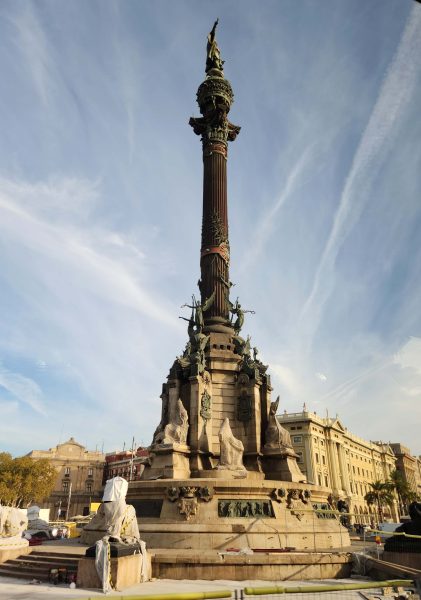
This sculpture is titled “Ones,” and is located at the entrance to the harbor breakwater. It symbolizes waves extending a welcome or a farewell to those arriving in or leaving the city of Barcelona by sea.
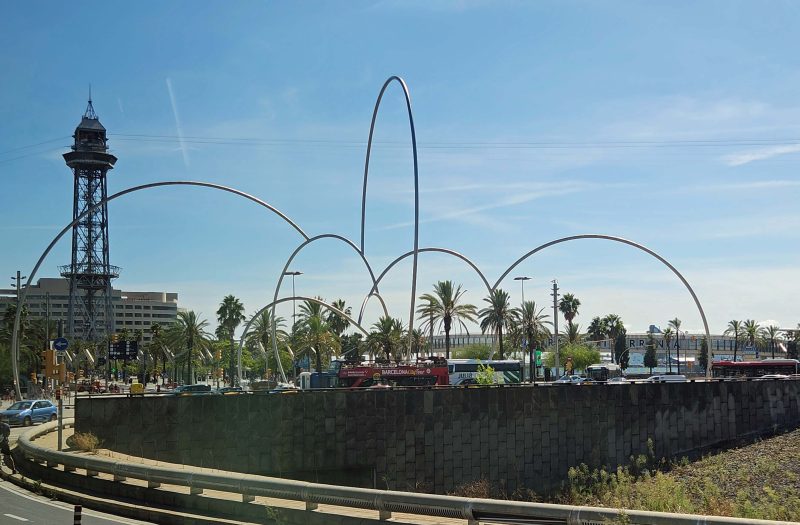
Barcelona’s Arc de Triomf (Triumphal Arch) was built in 1888 and was the main access gate for the 1888 Barcelona Universal Exposition.

The highlight—and I do mean highlight—of our day today was a visit to La Sagrada Familia (The Sacred Family), a Roman Catholic minor basilica. It is Antoni Gaudi’s masterpiece, and every part of its entire structure symbolizes the lifetime of Jesus Christ. Areas of the sanctuary represent saints, virtues, sins, regions, etc., and the three entrances to the sanctuary–the Nativity façade (the birth of Jesus), the Passion façade (the trial, suffering, and death of Jesus), and the Glory façade (the resurrection and everlasting life of Jesus)—are intricately carved to depict those three phases of Jesus Christ’s life. Only the Nativity façade was completed during Gaudi’s lifetime.
Construction of the church began in 1882. Work on the building was interrupted during the Spanish Civil War; later, it was delayed due to funding and conservation work; and in 2020, work was halted during the pandemic. Furthermore, in 1926, it was discovered that a building permit had never been issued, so construction was briefly stopped until a permit was granted. The building permit will expire in 2026, the most recent projected completion date, and the centenary of Gaudi’s death.
Gaudi predicted the church would take 200 years to complete, and he never expected to live long enough to see its finished form, so he left sufficient information regarding his ideas for others to develop. In 1926, as he was crossing a street on his way to meet with his model builder, Gaudi was struck by a tram and died. He is buried in a crypt in the Sagrada Familia.
At the time of his death, Gaudi had completed designs for the naves, the Passion façade, and a model for the sacristy dome, and he was working on designs for the crossing, the central towers, and the main façade (the Glory façade) when he died. He also left a full model of the church. The model was built on a 1:10 scale and was so large, you could walk inside and through it. That made it possible for people after him to continue the work on the church.
Gaudi’s main goal for the church was to teach people about Catholicism through architecture. For example, the three entrances to the interior represent the three virtues: love, hope, and faith. The 18 towers of the church are also symbolic, with 12 for the disciples, 4 for the evangelists, one for Mary, and the tallest, center tower for Jesus. The Sagrada Familia is the second largest church in the world (St. Peters Basilica in Rome is the largest), and the Jesus Tower, at 236 feet tall, will make it the tallest church in the world. Early in the design process for the church, a geodesist measured the tallest hill in Barcelona; then the central tower was designed to be one meter shorter than that hill because Gaudi believed no man’s work should be taller than a work of God. Zoning laws in Barcelona now prohibit buildings taller than the Sagrada Familia.
The first glimpse of the Sagrada Familia is stunning, both for its size and for its detailed decorations. There is an unusual piece of symbolism in the picture below. Look for a green cypress tree (it looks like a Christmas tree) on top of the short tower in the right center of the picture. You’ll see a flock of white doves flying around the tree, representing the tree of life which is always associated with sacred places.

This is the Nativity façade that depicts the birth of Jesus Christ, and it’s where we entered the church. Look at the detail of the building! To appreciate the scale of the Sagrada Familia, compare it to the size of the people at the door.
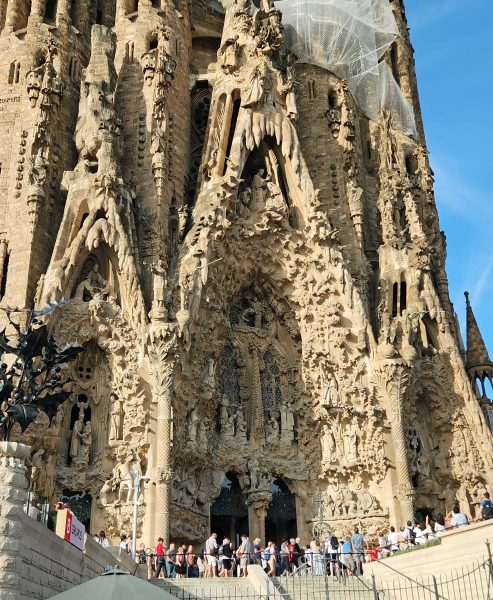
These sculpture groupings are above the doorway in the preceding photo. The sculpture on the left is the Nativity—Mary, Joseph, and Jesus. The center sculpture is Joseph with Jesus. Joseph was present at Jesus’ birth, but not at his crucifixion and passion, so Joseph only appears on the Nativity façade of the Sagrada Familia. The sculpture on the right depicts The Martyrdom of the Innocents when, following the news of Jesus’ birth, Herod the Great ordered the execution of all male children two years old and younger in the vicinity of Bethlehem.
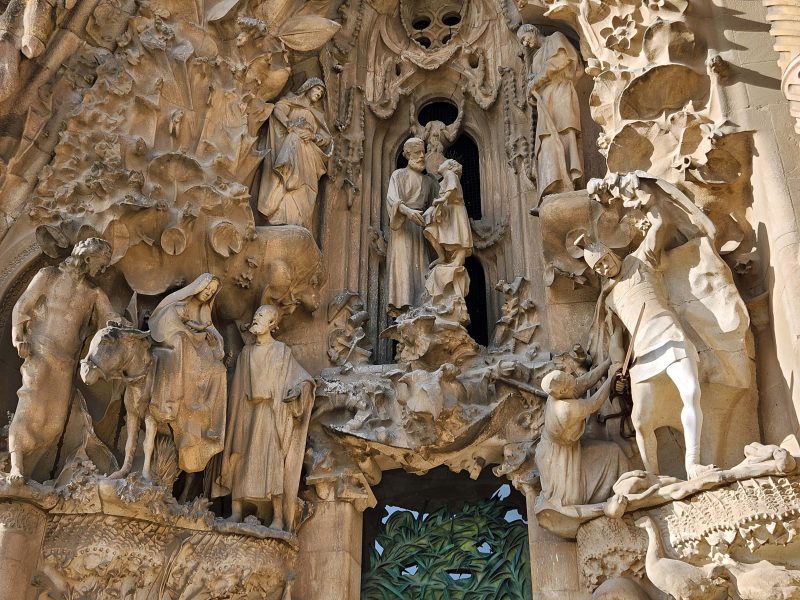
While we were waiting to enter the church, we examined this model of the Sagrada Familia. The gray parts indicate completed areas, but I’m not sure how current the model is. At the time of our visit, the statues of Matthew and Luke had been placed on their towers. Mark and John were standing in the nave. Mark’s head was attached—an indication that workers were preparing to add the sculpture to the top of the third evangelist tower; John was still headless. The Mary and Jesus towers were not yet finished.
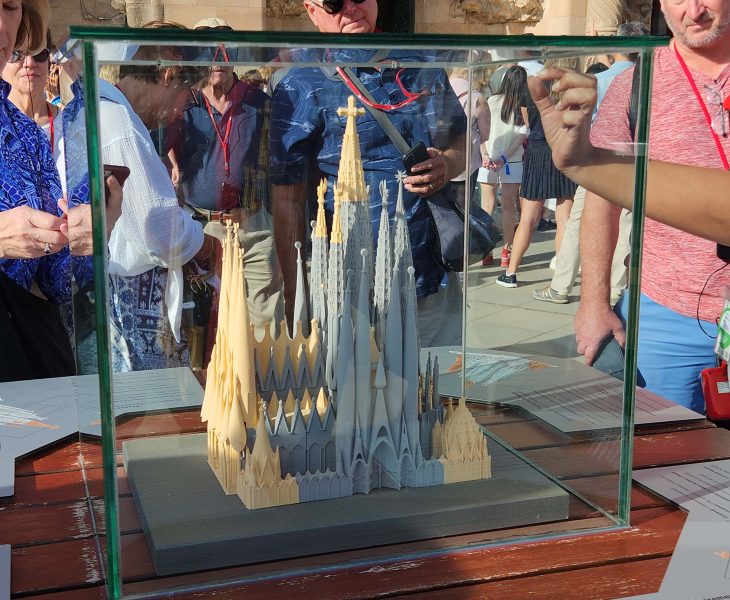
Standing at the Nativity entry, you can look across the nave to the Passion entry. The Glory entry (still unfinished) will be to the left of this picture and will serve as the main entrance to the church.
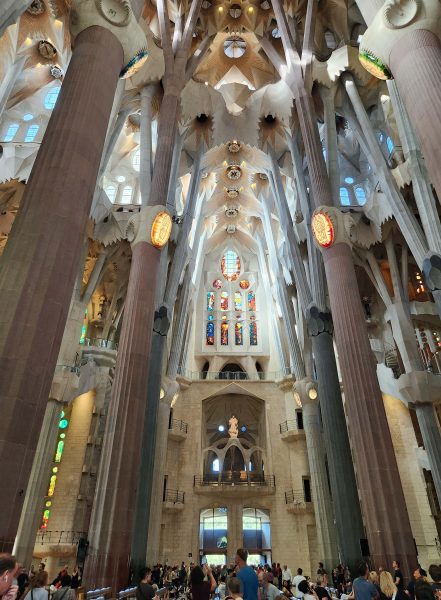
The interior dome, pictured here, was built according to Gaudi’s model. Four of the center columns have a lighted icon to represent each of the four evangelists.
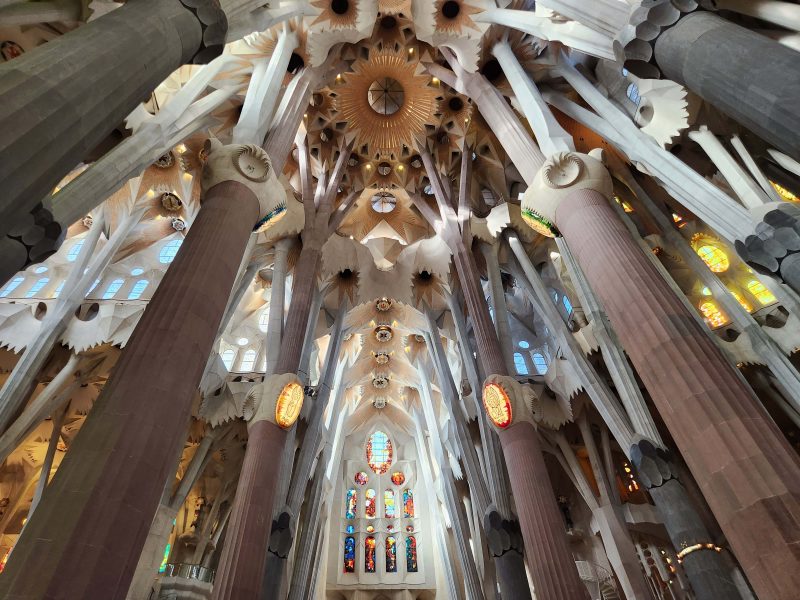
This is a close-up of the lighted icon for Mark.
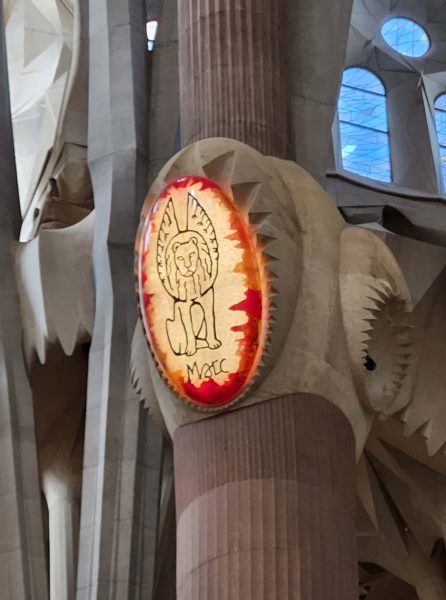
You can (barely) see the main altar and the pipe organ at the distant wall. It’s a long way from the back of the church. I was standing roughly halfway between the front and the back of the nave to take this picture. Only special services are held in this area (Christmas, Easter, etc.); Sunday services are held in a smaller chapel.
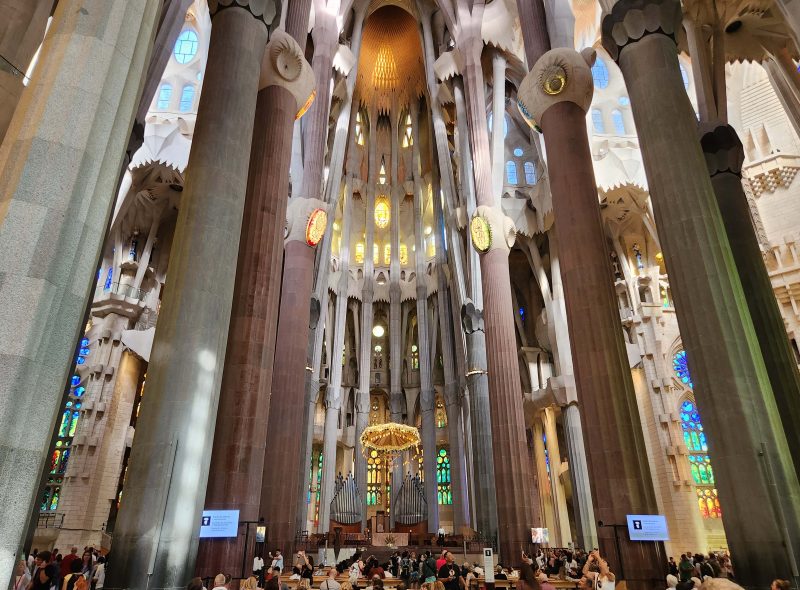
Gaudi believed that nature was the source of all knowledge and inspiration, so he included nature in his designs. He knew he would need buttresses to support the roof of the Sagrada Familia, but he hated buttresses and wanted the interior columns to resemble trees instead, as in nature. To make this possible, he built a model of the church, including its roof, and hung ropes from the model’s roof, then used them to place and design his columns. The columns are created in the form of tree trunks to evoke the illusion of a canopy of palm trees. Here’s a picture of the “tree colonnade.” With so many large, tall columns, you can’t help looking upward (to heaven?) when you’re in the building.
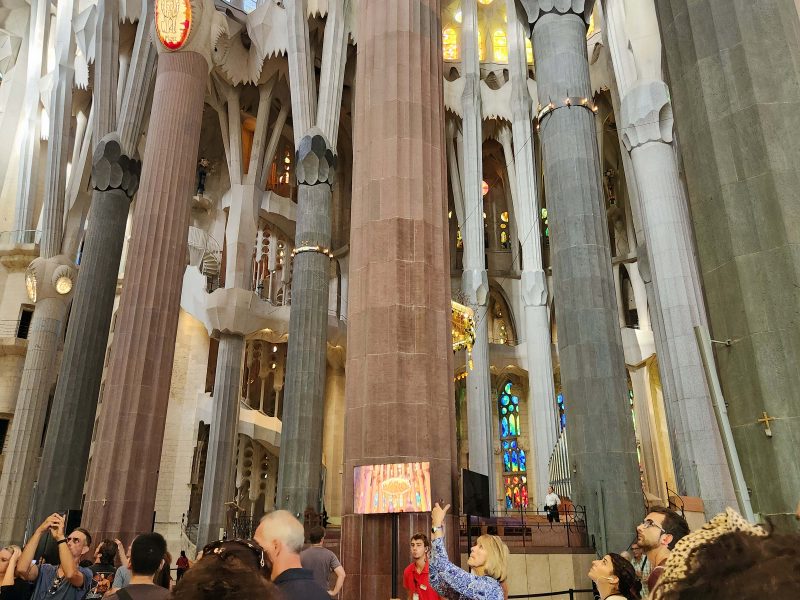
These are two of the large colored class windows in the nave. Each window features different colors in different places, so the light inside the nave changes with the position of the sun during the day.
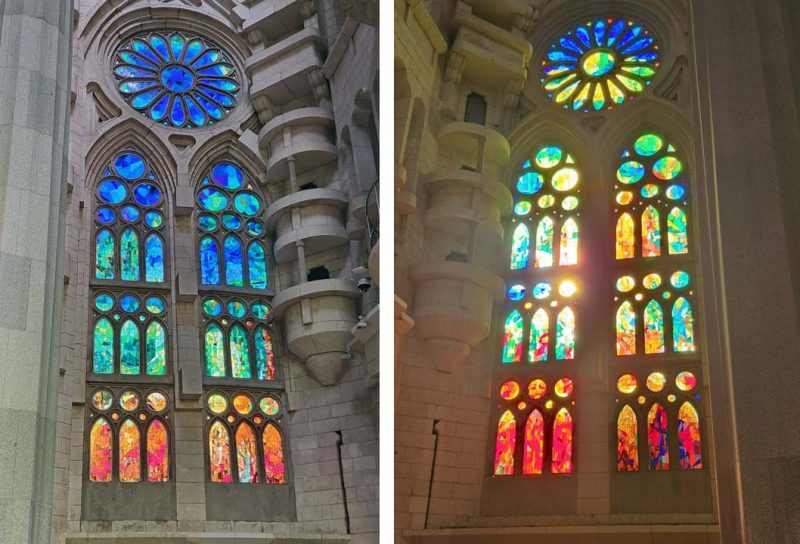
Every part of the Sagrada Familia is extremely detailed and every detail symbolizes something in the life of Jesus Christ. The objects on these rooftops are fruits and grains to represent the bread and wine of Holy Communion. Some of the objects resemble bananas, but a closer look shows that they are grains for bread. (Not banana bread.)

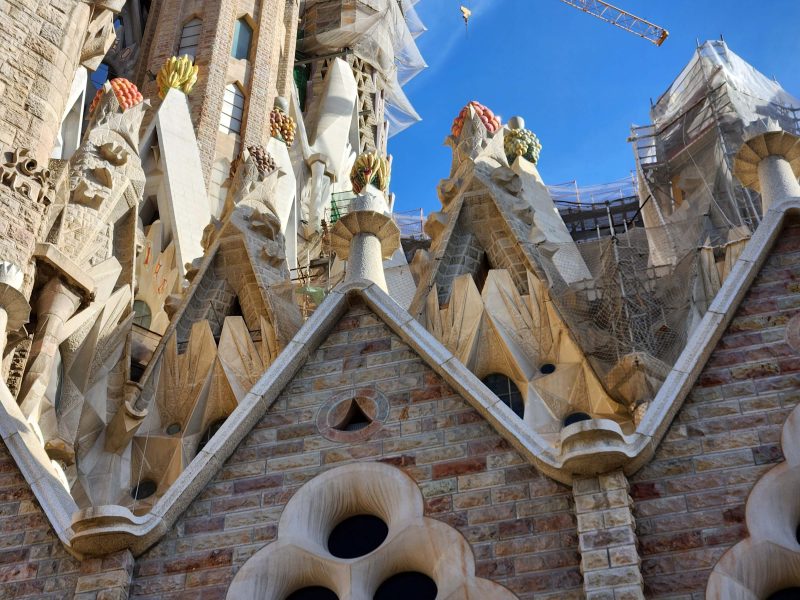
I’m not sure what the words–Honor, Podor, and Forca–on this rooftop mean, even though I looked up the translations and found, “honor,” “can,” and “strength.” Perhaps, given Gaudi’s devotion to God and his intent to tell the Christian story through his work, it means that with God’s help, we can live with honor, power, and strength.

The following photos are from the Passion façade. This one portrays the Last Supper.
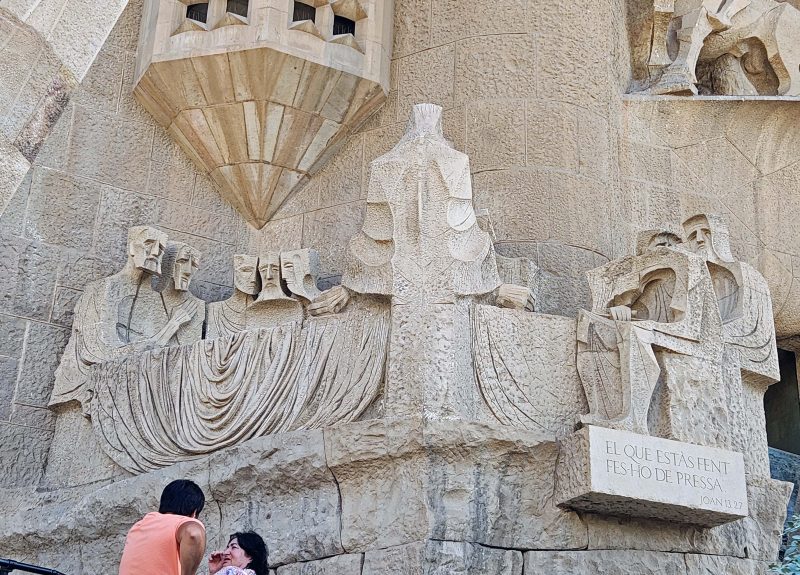
The figures on the right in this picture illustrate Judas’ betrayal of Jesus. Jesus was actually shorter than Judas, but Gaudi portrayed him as taller because Jesus has more power than Judas. If you look at the numerical plate on the wall, you’ll see that the four numbers in each row, each column, and both diagonals equal 33—Jesus’ age when he died. (Go ahead. You know you’re going to add them up to check.)
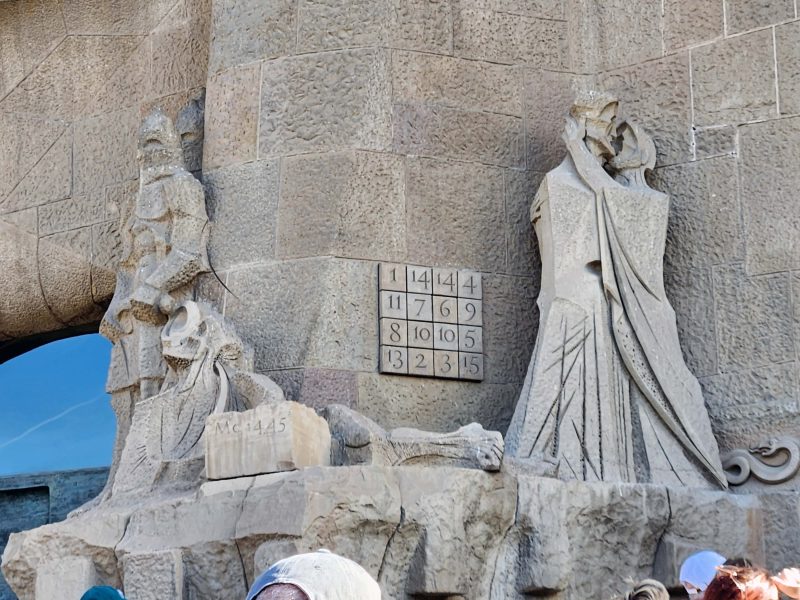
The sculptural grouping in this pediment depicts Jesus’ crucifixion. Gaudi intended this façade to be gloomy and to show the cruelty of the crucifixion. There are 18 bone-shaped pillars on this façade to symbolize those who died. The covered space they create is meant to convey the Bosom of Abraham, a place of comfort.
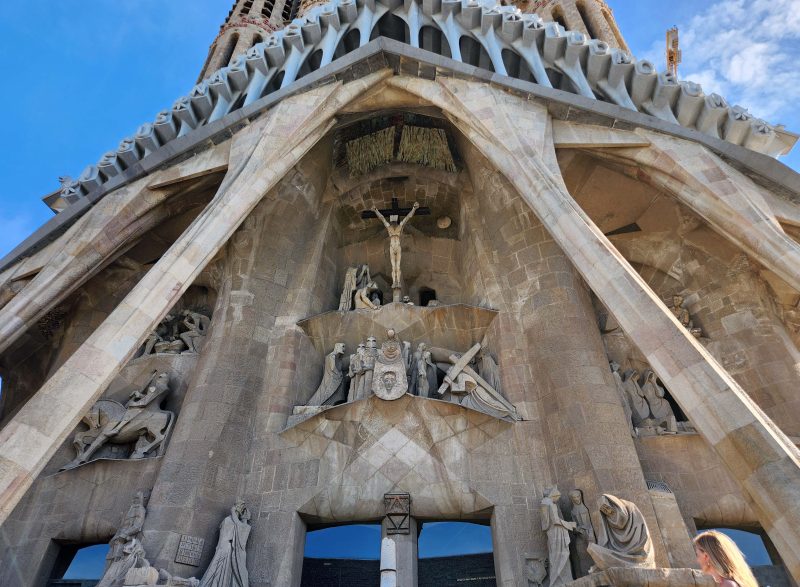
The figures in the grouping below Jesus on the cross are Roman soldiers. I don’t remember all of the symbolism, but I think the woman-like figure on the right might be Jesus’ mother, Mary, who witnessed his crucifixion. The skull at the foot of the cross is a symbol of death and refers to Golgotha, which is known as the “mountain of skulls” and is the place where Jesus Christ was crucified.
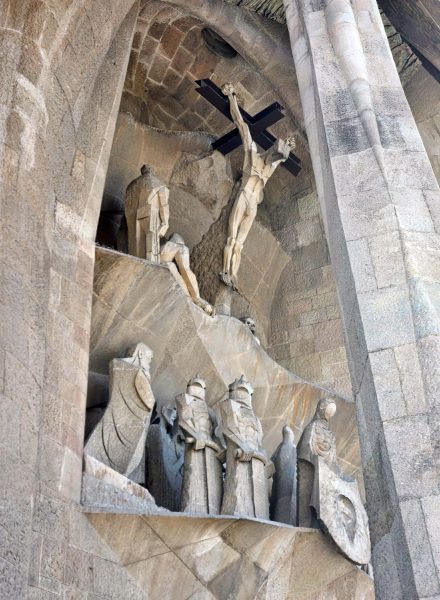
Every detail of the Sagrada Familia is a WOW! Our guide said she began studying the church when she was a teenager (she’s probably in her 30s), and she now gives four tours of it every day (I presume with some days off), but she still doesn’t know what everything in and on the building means. Every detail designed by Gaudi and those who followed him has a symbolic Biblical meaning. As the saying goes, “Oh, my Gaudi!”
I’m tempted to say this was the most amazing thing Ted and I saw on our 2023 BT, but then I think about other things we’ve seen, and I hear myself sounding like Ted. After every trip we take, he says he thinks it was our best trip ever. Then the next trip is the best trip ever, and so on. I might be feeling the same way about all the wonderful things we saw and did on this trip. Still, La Sagrada Familia sets a high bar for everything else and left us on a high note on the last day of our 2023 BT.